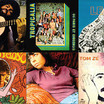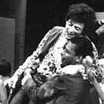Eubioticamente atraídos

tropicália: portrait of a revolution
Foreign views
TROPICÁLIA: PORTRAIT OF A REVOLUTION
Marcelo Ballvé*
Nacla News, 28 de fevereiro de 2007
It was exactly forty years ago that the musical revolution that came to be known as Tropicália was introduced to Brazil, and the world. Tropicália’s genesis can be dated with some precision. It came when two musicians in their mid-twenties, Caetano Veloso and Gilberto Gil, courageously took to the stage at a 1967 song festival in São Paulo with compositions that they knew would sorely stress the boundaries of musical taste. Their performance was epoch-defining. It was a kind of big bang from which much that came afterward in Brazilian pop music history evolved.
In part to needle what he expected to be a conservative audience, Veloso had selected an eccentric, long-haired band of Argentine rockers for his backup band, at a time when long hair was still nearly taboo, and delivered a song, “Alegria, alegria,” or “Happiness, Happiness,” which electrified the booing audience into silence. “Alegria, alegria” was an unmistakable departure from Brazil’s songwriting tradition. It was an erudite reworking of archaic genres (the song is set to the rhythm of a marchinha, an Afro-Brazilian form influenced by ragtime in the 1920s) organized around a trinity of electric guitar chords. The song’s contemporary references to Coca-Cola and television, and the absence of comfortable nostalgia or sentimentalism marked it as an unmistakable artifact of the sharp-edged, uncertain present in a Brazil of military dictatorships and political ferment.
The next day, at the same festival, Veloso’s partner in crime, Gil, sang an equally provocative tune, “Domingo no parque,” or “Sunday in the Park.” The lyrics centered on a double-murder committed by a jealous lover, and the musical arrangement was clearly influenced by the Beatles. However, the song also contained the ubiquitous sounds of a berimbau, a traditional, resonating instrument of African origin made of a gourd, a wooden bow and a metal string. It was a novel melding of tradition and the cutting-edge.
The two musicians had intentionally set out to trigger a musical upheaval, and they succeeded. Their movement, Tropicália, went on to sweep away the petty divisions that up to then had divided Brazilian rockers from bossa nova die-hards and old school samba crooners. Tropicália would combine the cosmopolitan sensibilities and lyrical precision of rock with the entire geological depth of Brazil’s considerable musical tradition.
ACQUIRING THE TASTE
The music of Tropicália (also sometimes known as Tropicalismo) has been with me nearly my whole life , though it has taken me nearly as long to fully acquire a taste for it. In the late 1970s in Argentina, my parents, uncles and aunts were still listening to the singers that had championed the movement during its short but frenzied peak a decade before in neighboring Brazil. But it wasn’t until I was myself living in Rio de Janeiro in 2000 that I began to make the music my own. At an outdoor market near my apartment in Copacabana Beach I bought Tropicália 2, an album Caetano Veloso and Gilberto Gil recorded in the early 1990s celebrate the 30th anniversary of their friendship and the 25th anniversary of Tropicália.
I bought the album because I recognized the two names as belonging to perhaps the most famous of Brazil’s many internationally known musicians, but the contents surprised me. This was not smooth Brazilian pop: the tracks were weird enough that many of them did not register beyond leaving an impression of general strangeness and what seemed to be swirling, mysterious reinterpretations of older musical forms. The problem was that I was not familiar with these forms in their original version. Challenging as the album was, it had a discernible, melodic heart. It had a social conscience as well (the political urgency of a track called “Haiti” was unmistakable), and it had many beautiful moments, such as the sublime, flute-laced intro to “Baião Atemporal.” It was this album which kept me hooked on Brazilian music from then on, though I pursued my interest only in a scattershot manner over the next half-dozen years.
Then, something decisive happened. By chance, I began listening to samba records, mainly to older artists from Rio’s slums that had recorded a number of landmark albums in the 1970s. These were people like Cartola, a gravelly-voiced singer, composer, and co-founder of the Estação Primeira de Mangueira samba school in 1928. He was rediscovered in the 1970s, after surviving decades of total obscurity. Though I didn’t know it at the time, this rediscovery of Cartola happened in part thanks to the interest in musical tradition encouraged by Tropicália itself. My musical journey was beginning to double back on itself. Samba led me, by a maze-like series of artists and discographies, to bossa nova (samba refined and rarefied), and finally, to Jorge Ben.
I had arrived. Jorge Ben’s 1976 album África Brasil was a revelation. I didn’t need fluency in Brazilian rhythms to understand that this was a masterful remixing of centuries of musical history, delivered in the funky idiom of the 1970s. Not only that, but Ben transformed his album into a kind of document for the Black experience in Brazil, working Egyptian legends, slave history, and occult philosophical knowledge into his lyrics. Every minute in the album yielded ideas and surprises. While it was shot through with the spontaneity of genius, it was also clearly a unified work, deeply meditated and stitched together with allusions and themes that made the album spin in my head for days, beginning to end, and end to beginning, like a gleaming, baroque Ferris Wheel.
I didn’t know it when I first heard him, but Jorge Ben was a kind of godfather to the Tropicália movement. He was acknowledged as a precursor, worshipped and somewhat feared by Veloso and Gil, who sometimes trembled at the knees in the shadow of Ben’s prodigious talents. It was Ben’s earlier albums in the 1960s that pointed the way to what Tropicália ultimately accomplished. Veloso himself pays homage to Ben in his brainy 1997 book that tells the story of Tropicália’s origins and meteoric rise: Verdade Tropical (published in English by Da Capo Press in 2002). Veloso writes: “(Jorge) Ben became a symbol, a myth, a master for us.”
THE NEW IN THE OLD
It’s no surprise, then, that after listening to Ben’s music I also was able to process, if not love, anything the Tropicália crowd threw my way, whereas before much of their music mystified me. Often weird, occasionally abstruse and absurd, always conceptually elaborate, the tropicalistas of the late 1960s and early 1970s were as much about ideas as they were about music.
With Ben’s music as a sort of map, I could enjoy the rocked-out, feedback-heavy, portions of Gal Costa’s two-headed monster of a live album (Fa-Tal/Gal a todo vapor); whereas before I could only stomach her more accessible and mellow acoustic set. Now, I could make a kind of sense out of Jards Macalé’s music. Macalé, a late, radioactive rhizome offshoot of Tropicália, was all about turning pop music inside-out with groove-happy deconstructions or haunting melodies that always seemed on the verge of fading into dissonance, but never did.
I still preferred Ben. A one-man music laboratory, he seemed to arrive at his inventions effortlessly, while Tropicália sometimes was heavy-handed (as Veloso himself admits in his book). Both were after the same thing, though: excavating the new out of the old, delivering a sound that while filigreed with tradition was completely a new proposition.
In his book Veloso quotes Brazilian critic and poet Augusto de Campos on the concept of novelty. “The old that was once new is as new as the newest of the new,” writes Campos, whose concrete poetry movement heavily influenced Tropicália. Campos is offering more than just a tongue-twister with this formulation. What he’s proposing is a different attitude toward the past than that espoused by the traditional posture of revolutionaries in the arts. Instead of throwing out the past, he suggests a more transversal view of cultural history in which the peaks of creative efflorescence across the ages are joined into a kind of timeless, immortal New.
Much the same concept was advanced by Veloso on the back jacket of his 1967 joint album with Gal Costa, Domingo: “I no longer desire to thrive on nostalgia for other times and places; on the contrary, I wish to incorporate that nostalgia into a future project.” According to Veloso, this is as close as he ever got to putting the Tropicália manifesto into writing.
THE LIMITS OF UTOPIA
Of course, Tropicália’s future was not to be limitless. In fact, the movement’s real existence was rather brief: it was launched in 1967 and had run out of steam by 1972. Brazil’s military government did what it could to suffocate a movement that consciously sought to create the soundtrack to Brazil’s counterculture, with lyrics that were critical of hypocrisy in the upper classes and the country’s abysmal economic inequality. Gil and Veloso were imprisoned and exiled to London for several years, returning to record some final thoughts on Tropicália in 1972. Apart from the repression its artists suffered, the movement’s self-consciously vanguard approach gradually rendered itself irrelevant by having largely achieved its principal aim: clearing prejudices from the musical establishment. Like many revolutions, its star faded once its message had seeped far enough into popular consciousness. What was left was an afterglow of radical acoustic open-mindedness in which MPB, or música popular brasileira, continues to bask today, to its great benefit.
Veloso writes an accurate eulogy for Tropicália in his book, evoking the grand aims and partial victories: “We had not attained socialism, had not even found its human face; neither had we entered the Age of Aquarius or the Kingdom of the Holy Ghost; we had not overcome the West, had not rooted out racism or abolished sexual hypocrisy. But things would never be as they had been.”
In other words, Tropicália had sought a musical and social utopia and failed. Yet its failure is one of the greatest successes in the history of a great musical nation.
* Marcelo Ballvé’s work has been published in The New York Times, The San Francisco Chronicle, The Washington Post, The Christian Science Monitor, NACLA: Report on the Americas and other publications.























